Oxalis triangularis (Purple Shamrock) is a fast-growing rhizomatous wood sorrel that looks like a butterfly during the day but closes up shop at night.
We’ll cover how to propagate your Purple shamrock using its pinecone-shaped corms, the most common care issues which come up, and some tips for getting it to show you its gorgeous bloom.
We’ll also briefly cover the varieties (there are quite a few) and the unique fungal issues this plant can have. Let’s dive in.
Table of Contents
Oxalis Triangularis Care Guide
History, habitat, and characteristics
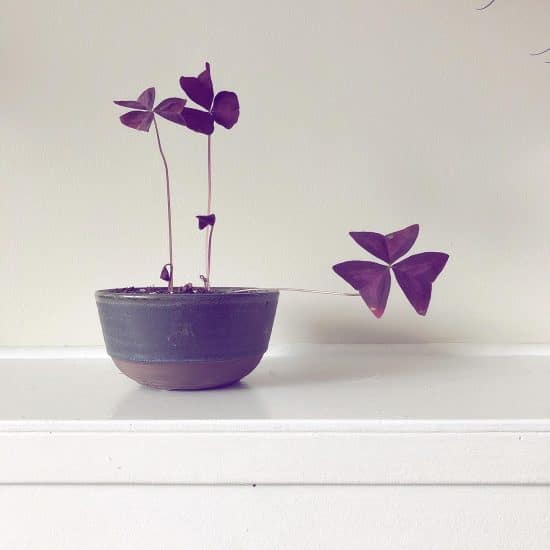
Oxalis triangularis (also called False Shamrock and Purple Shamrock) is an indoor plant native to South America. Although it calls Brazil home, it has spread to other parts of the world, from India to the US. Augustin Saint-Hilaire first scientifically described this plant in the early 1820’s. He named it for its trifoliate leaves that look remarkably like butterflies.
Particularly coveted during St. Patrick’s Day, when bright green varieties are in high demand, it comes in a variety of other beautiful hues, including purple and pink.
A fast-growing rhizomatous wood sorrel typically reaching between 2-6 inches tall in its pot, its leaves will close up at night or when it’s dark and stormy (just like me), then reopen during the day. You might also notice leaves closing up after touch, so don’t be surprised if they get a bit droopy if excessively handled.
This magical nyctinasty behavior is just one of the wonderful traits that make Oxalis triangularis plants so special. Small white or pink flowers on each leaf add yet another layer of cheer.
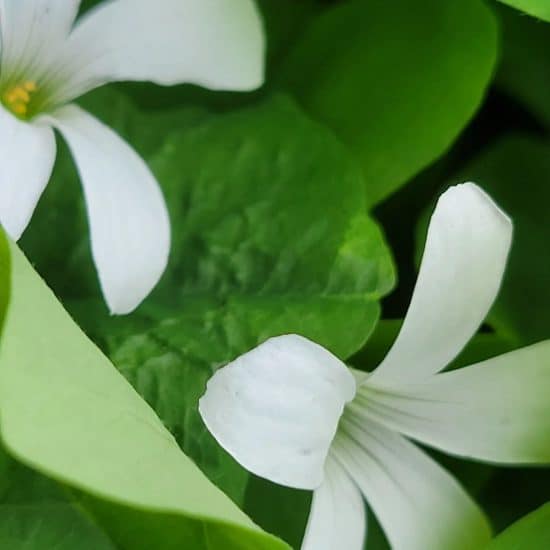
Oxalis triangularis can be used to make a delicious, tart-tasting lemonade — the leaves and flowers contain oxalic acid. The taste is similar to the tartness found in the skin of a grape.
(This same oxalic acid is what gives it a unique resistance to fungi in the soil).
We’ll cover how to propagate Purple shamrock right after our care guide, but first, a note on varieties.
Oxalis triangularis varieties
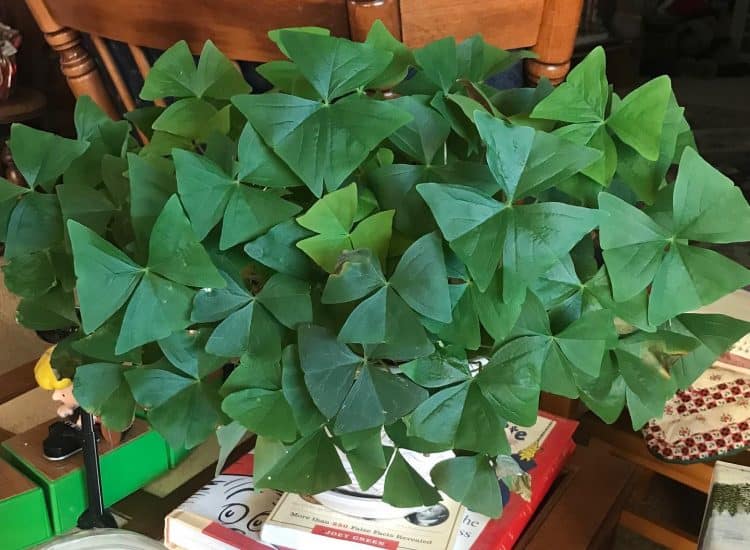
Things get tricky when we start to consider the Oxalis triangularis varieties and heirloom plants available. Many plants sold as this species are actually entirely different plants (with different care requirements).
There’s a large incentive for nurseries to label plants according to what’s currently popular, so you might get a surprise when shopping or see varieties that you’ve never heard of befor,e or that you can only find at a single nursery.
Often, these are imported bulbs that may only be propagated for a limited time. So if you like one, grab it and make some clones for your friends once it’s thriving!
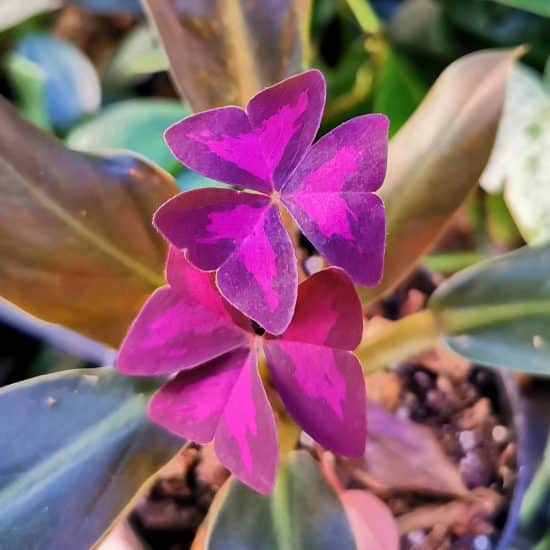
Popular varieties include:
- Oxalis triangularis ‘Amber’ – This purple shamrock isn’t purple at all! Solid green leaves with bright pink flowers.
- Oxalis triangularis ‘Burgundy Wine’ – Deep purple shamrock that looks stained with wine, complemented with white-to-purple flowers.
- Oxalis triangularis ‘Irish Mist’ – Variegated green leaves with splashes of cream.
- Oxalis triangularis ‘Sanne’ – Yellow-ish green leaves with soft pink flowers.
- Oxalis triangularis ‘Sunny’ – Unique wood sorrel variety. This plant features dark black/purple leaves with just a hint of lighter pink and purple within.
- Oxalis triangularis ‘Atropurpurea’ – This variety is similar to ‘Purpurea,’ but it has dark purple leaves and pink flowers.
- Oxalis triangularis ‘Mijke’ – A lighter pink with less bordering on the leaves.
- Oxalis Iron Cross (Good Luck Plant) – Bright green shamrock-like edges with a dark purple cross center. Different species, but similar care.
- Oxalis Triangularis ‘Ebony Allure’ – Deep purple foliage that borders on black depending on the lighting.
- Oxalis “Irish Mist” – Another shamrock plant twin, actually a different species with three leaves and delicate white/creamy variegation on green leaves.
- Oxalis triangularis ssp. papilionacea – Spring green leaves with an abundance of white flowers.
- Oxalis triangularis ssp. papilionacea ‘Fanny’ – Similar to the last variety, ‘Fanny’ also features gentle green variegation within the leaves.
Light
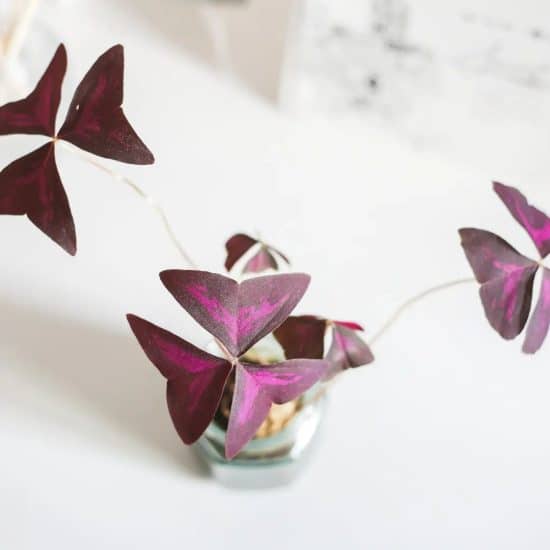
Oxalis triangularis thrives in a bright location with plenty of bright indirect sunlight.
Sunlight varies by window, so you’ll want to check out which direction your windows face. For example, near a north-facing window, the shamrock plant can often do well 1-3 feet away, as this light is often plentiful and indirect.
So how can we tell if a false shamrock is getting enough light? Check its leaves closely.
If they’re yellowing, losing their vibrant color, showing muted variegation, or curling inward, these could be signs of not enough light. Similarly, if the stems are growing leggy and long, this is a good sign in Purple shamrocks that they need a bit more light. Time to move these plants to a brighter location.
Water
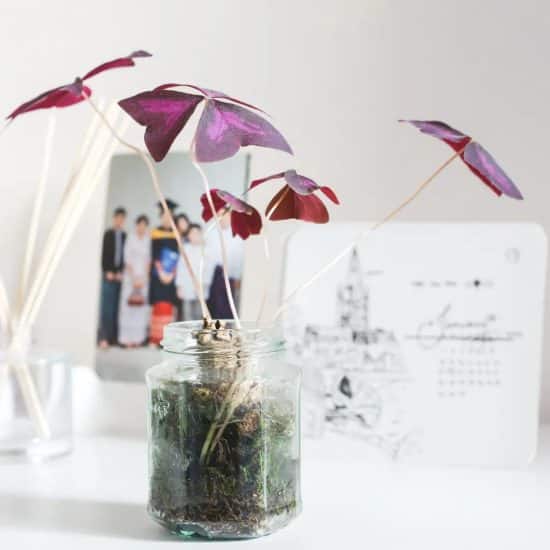
Oxalis triangularis isn’t especially sensitive to water and can adapt pretty well (this is true of a lot of plants in the wood sorrel family) to your schedule. But your schedule shouldn’t be static — it must depend on the actual moisture of the soil.
You’ll see other guides mention amounts per week, but honestly, there are so many variables (indoor temperature, humidity, type of soil, size of pot and plant) that you need a method to always know if it’s time to water, even as you’re learning about your plant.
This method is the same for almost every plant: you test the soil with a finger (a few inches deep) and really get a sense of how moist the soil is. If it’s still wet, you can wait a bit more before watering. If it’s a small pot, just be careful not to disturb the root structure too much.
Tips
- Water oxalis triangularis only when the top 1-2 inches of soil is dry. Test for dryness by sticking a finger into the soil.
- During the growing season (spring-summer), water more frequently. During the dormant season (fall-winter), water once every two to three weeks.
- When watering, use room temperature water thoroughly until it runs out of the bottom of the pot. Empty the drainage tray afterward.
- Signs of an underwatered plant include: wilting, brown leaves, just an overall sad-looking plant. You’ll recognize it immediately.
Temperature and humidity
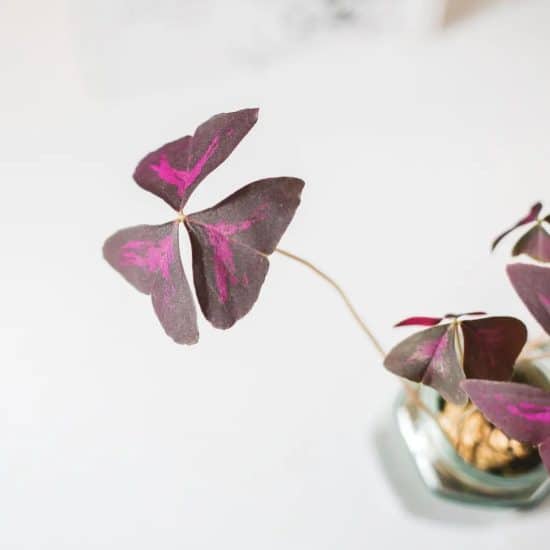
Caring for Oxalis triangularis or false shamrock is like having a toddler in your house – you have to keep a watchful eye on them as they’re growing and sensitive to their environment. But give it a few more years (hopefully less than that) and they’ll basically take care of themselves. Okay, maybe not quite true of this plant (or a toddler).
Where were we? That’s right, temperature and humidity. It’s not quite as hard as it’s made out to be, and you’ll soon be rewarded for your hard work.
Let’s start with temperature. Oxalis triangularis loves to lounge in temperatures between 60-75F. Anything below that, and these plants can take on a semi-dormant state and might lose some leaves.
Keeping the humidity between 40%-60% is great for these tropical babies, which you can easily achieve with a few tricks. Setting up a small humidifier next to the plant or placing it on a tray of wet pebbles both work. If you have other indoor plants, cluster them together to raise both the local humidity and temperature.
Soil and planting
Oxalis triangularis (Purple shamrock) does best in loamy potting soil.
So what makes soil loamy? It’s a mixture of clay, silt, and sand.
Each element contributes its own advantages: silt (being fine) and clay have more surface area per volume, letting them hold more water than larger particulate. Sand is great at providing aeration (it doesn’t get compacted like silt and clay can).
Between the three, we have a great balanced combination of water retention, aeration, and nutrition. The only downsides are really that some plants like a more acidic or alkaline soil, and it can become compacted over time.
We can fix that.
We’ll add perlite or LECA to our False shamrock potting soil, which both have a lot of surface area (being hollow and porous) but also occupy a lot of space, meaning they add water retention while reducing compaction.
Fertilizer is fine to use during Purple shamrock’s growing season (spring/summer), but make sure to dilute. Don’t fertilize immediately after repotting, as this can cause damage to the plant. We recommend a balanced liquid houseplant fertilizer diluted to 50%, as over-fertilizing can damage the leaves.
Propagation guide
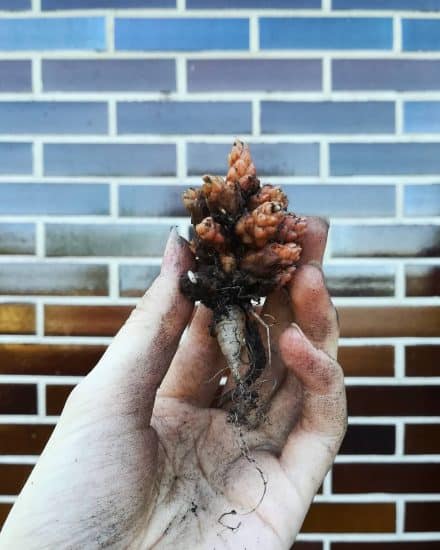
Oxalis triangularis is a perfect candidate for division propagation, so that’s the technique we’ll cover. Division involves separating a mature plant into multiple sections, which is great for any plant that naturally forms clumps or offset, like Oxalis triangularis does with its corms.
The main advantage over stem cutting is that you start off with a mature root system and a pretty healthy plant, and you can distribute it right away to a friend in fresh soil.
Unlike some plants we propagate this way, we want to make sure purple shamrock is within its dormancy period. Leaves should have begun to die off, which means their nutrients have been reabsorbed into the corm (like a bulb). We can begin the process a few weeks into this period.
Propagating Oxalis triangularis by division
- First, you’ll want to make sure the roots of the mature plant are healthy and well-established.
- Carefully remove your plant from its pot and use a knife or scissors to separate it into several smaller clumps. Some roots might break off — just discard them.
- You’ll notice pinecone-like corms. These are the bulbs that we’ll separate into new plants.
- Replant into a new pot with fresh potting soil and water.
Especially since your plant should still be in its dormancy period, make sure not to fertilize right away. Save that for the growing season.
Common issues
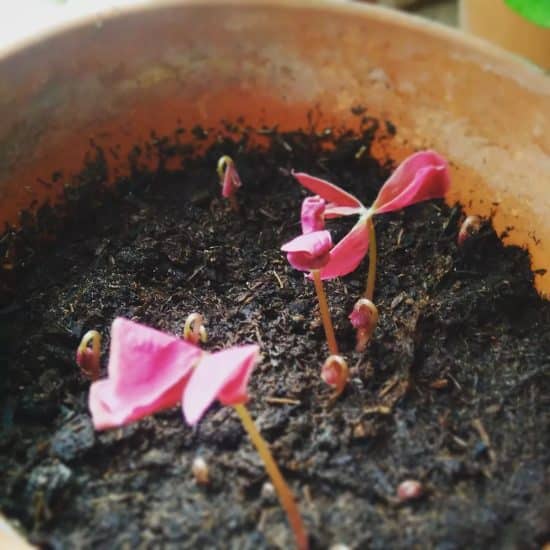
Purple shamrock suffers from a lot of the same common issues as other indoor plants. Most of them are easily solved with a little bit of investigation. Let’s cover the top three and how to figure out their causes.
Dormancy period
Most indoor plants are tropical plants that developed under the canopy of a rainforest. They expect pretty consistent temperatures, indirect light, and constant humidity. People tend to keep their houses at a consistent temperature, so these plants really only notice a decrease in light.
Purple shamrock plants evolved to go through a dormancy period every winter. The leaves fall off, there are no flowers, and you’ll notice reduced growth. With less light also means less water: too much water and your Purple shamrock corm will experience stress and rot.
Remember: less light = less photosynthesis = less water consumption.
Indoors, we keep a pretty consistent temperature, but humidity and light both drastically change in the winter. Purple shamrock can sense these changes and begins preparing for a period of lower energy consumption and production. If you want to avoid dormancy, this means using LED lights (ideally full spectrum) and keeping up the humidity. If you do this, it should stay within its growing period.
This isn’t necessarily a period to avoid, though, but a unique feature of owning a Purple shamrock. Don’t worry, it’ll come back in the spring! Let it rest and recover.
If all of your plant’s leaves fall off suddenly, this is a larger issue and warrants an investigation of its light and water conditions.
Brown and yellowing leaves
Oxalis triangularis, like other houseplants, can suffer from browning and yellowing leaves if it’s exposed to too much direct sunlight. This can occur rapidly, and if left unchecked, can cause irreparable damage. If your plant exhibits this symptom, move it to a spot further away from the window and use translucent curtains or blinds to lessen the intensity of the light that reaches it.
Limp/Drooping Leaves
Limp or drooping leaves can indicate dehydration but is often more likely due to the soil mix the plant is in. If your Oxalis triangularis is not in a soil mix with proper drainage, it will be more likely to suffer from wilt due to insufficient hydration. Repot it into a mix with more drainage and water more frequently, making sure to ensure the soil is damp all the way through.
Diseases and pests
Oxalis triangularis does suffer from a few unique issues as an indoor plant, but most of these are problems that can affect all plants in a weakened state. The best preventive is proper care and attention before these more complicated issues arise.
Root rot
Root rot occurs when the roots of the Oxalis triangularis are kept moist for too long. This can be caused by either frequent watering, improper soil composition, or a container without bottom drain holes.
If your plant is already showing signs of root rot, you’ll need to cut away any affected roots (they’ll be brown or black and mushy) and repot in fresh soil. Make sure to sanitize the scissors or knife you use after so you don’t transfer the rot to another plant.
Fusarium Wilt
Fusarium Wilt is a fungal disease like powdery mildew caused by Fusarium oxysporum. You’ll notice wilting leaves that turn yellow and brown. The infected leaves will usually appear on one side of the stem and eventually spread throughout the plant.
This disease is difficult to spot, as the plant and soil usually show no outward symptoms until it sets in, so it’s best to prevent it from ever taking hold. This means well-draining soil that gets some light to kill off any spores. Often, these spores are already in your soil and are activated by excessive moisture.
Any affected leaves need to be cut off and disposed of, and often this can cause you to lose an entire plant, so be careful. Don’t let that soil stay soggy.
Pests
The Oxalis species does suffer from a lot of common indoor plant pests like mealybugs, whitefly, or spider mites. You’ll notice them on the undersides of leaves along with cottony webbing. Outdoors, we can rely on aphids to eat these pests, but indoors isn’t as attractive of a location for ladybugs, so you’ll likely have to isolate your plant and spray it with neem oil.
Spider mites should be physically removed with a spray of cold water and wiped off with a Q-tip dipped in alcohol.
Conclusion
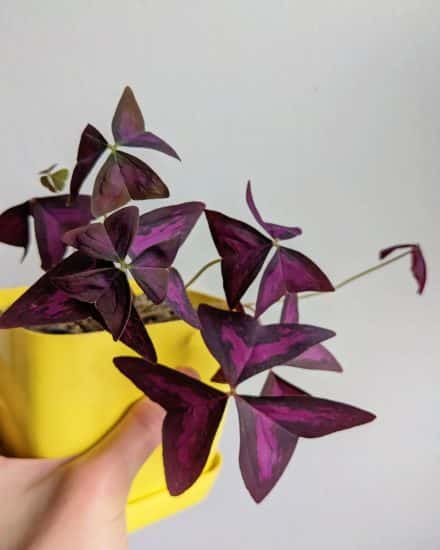
Oxalis triangularis (Purple shamrock) is a beautiful indoor plant that, like the prayer plant, shows signs of nyctinastic behavior (its leaves like to dance at night).
Purple shamrock leaves begin a bit greener at first with new growth and often settle into their mature color as they age.
Purple shamrocks do well in moist soil with adequate drainage, and if you treat them well with plenty of indirect light, you’ll be rewarded with a beautiful flowering period.
If you have any questions on Oxalis triangularis care that weren’t covered in our guide or have discovered a new variety of your own, please let us know in a comment!
FAQ
Does Purple shamrock require bright light?
About as much as other indoor plants. If you move your Purple shamrock into a new location and it isn’t thriving in a few weeks, the first thing I’d suspect is not enough bright indirect light or too much direct sunlight.
Purple shamrock’s color tends to come out (along with its flowers) when these conditions are just perfect, so use that as a guide for tweaking.
What are wood sorrels?
Considered a weed in North America, they’re also known as “sourgrass” (a fitting name when eaten raw). New growth appears throughout the year until winter, when they go into a resting period.
What is the difference between Oxalis triangularis, false shamrock, and the purple shamrock plant?
Oxalis triangularis, False shamrock, and Purple shamrock are all the same plant! Plants receive a botanical name typically given by the first person to properly isolate and describe them, but nurseries and local garden centers will often rename/brand plants to sell more or to distinguish them from other similar-looking plants. Hence the “false shamrock” moniker.
Why is it called a false shamrock? Is it supposed to turn green?
This is to indicate it’s not a true shamrock or clover (Trifollum). A false shamrock plant has very different care (and a more acidic taste, so avoid eating in large quantities).
False shamrocks can be green, but they’ll be of a variation that is always that color. They traditionally shouldn’t turn from purple to green.


